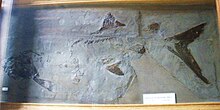Chondrosteus is a genus of extinct marine actinopterygian (ray-finned fish) belonging to the family Chondrosteidae. It lived during the Hettangian and Sinemurian (early Early Jurassic) in what is now England.[1] Chondrosteus is related to sturgeons and paddlefishes as part of the clade Acipenseriformes, and is one of the earliest known definitive members of the group.[2] Similar to sturgeons, the jaws of Chondrosteus were free from the rest of the skull (projectile jaw system). Its scale cover was reduced to the upper lobe of the caudal fin like in paddlefish.[3]
| Chondrosteus Temporal range:
| |
|---|---|

| |
| Chondrosteus acipenseroides fossil from Teylers Museum, Haarlem | |
| Scientific classification | |
| Domain: | Eukaryota |
| Kingdom: | Animalia |
| Phylum: | Chordata |
| Class: | Actinopterygii |
| Order: | †Chondrosteiformes |
| Family: | †Chondrosteidae |
| Genus: | †Chondrosteus Egerton, 1858 (ex Agassiz, 1834) |
| Species: | †C. acipenseroides
|
| Binomial name | |
| †Chondrosteus acipenseroides | |
| Synonyms | |
| |
It is represented by a single species, C. acipenseroides, from the Blue Lias of Lyme Regis. This species was first mentioned by Louis Agassiz in 1834, but was not officially described until 24 years later by Philip Grey Egerton, who used Agassiz's original name for the taxon.[4][5] The species C. crassior Egerton, 1858 and C. pachyurus Egerton, 1858 differ from C. acipenseroides only in size and ossification of plates, and likely only represent ontogenic growth stages of C. acipenseroides. The only known Chondrosteus specimens outside of Lyme Regis are a poorly-preserved specimen from Barrow-on-Soar and a Hettangian-aged post-cranial skeleton from Watchet in a private collection, which represents the oldest record of the genus.[2]
The species Chondrosteus hindenburgi from the Toarcian (late Early Jurassic) of Germany was reallocated to the genus Strongylosteus. Although some authors have suggested that the latter might be a junior synonym of Chondrosteus, there are no recent comparative studies on these two genera.[3]

References
edit- ^ "Chondrosteus". Paleobiology Database. Retrieved March 16, 2012.
- ^ a b Hilton, Eric J.; Forey, Peter L. (2009). "Redescription of †Chondrosteus acipenseroides Egerton, 1858 (Acipenseriformes, †Chondrosteidae) from the lower Lias of Lyme Regis (Dorset, England), with comments on the early evolution of sturgeons and paddlefishes". Journal of Systematic Palaeontology. 7 (4): 427–453. Bibcode:2009JSPal...7..427H. doi:10.1017/S1477201909002740. S2CID 86821521.
- ^ a b Bemis, William E.; Findeis, Eric K.; Grande, Lance (1997). "An overview of Acipenseriformes". Environmental Biology of Fishes. 48 (1–4): 25–71. Bibcode:1997EnvBF..48...25B. doi:10.1023/A:1007370213924. S2CID 24961905.
- ^ Agassiz, Louis (1833). Recherches sur les poissons fossiles (in French). Imprimerie de Petitpierre.
- ^ Hornung, Jahn J.; Sachs, Sven (2020-01-22). "First record of Gyrosteus mirabilis (Actinopterygii, Chondrosteidae) from the Toarcian (Lower Jurassic) of the Baltic region". PeerJ. 8: e8400. doi:10.7717/peerj.8400. ISSN 2167-8359. PMC 6982408. PMID 32002331.
External links
edit- Media related to Chondrosteus at Wikimedia Commons